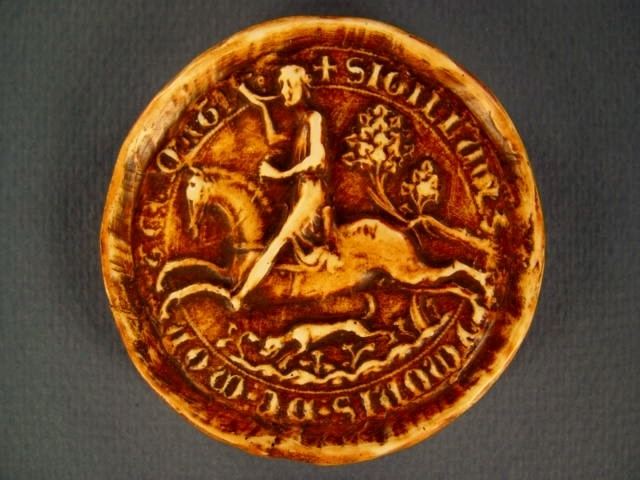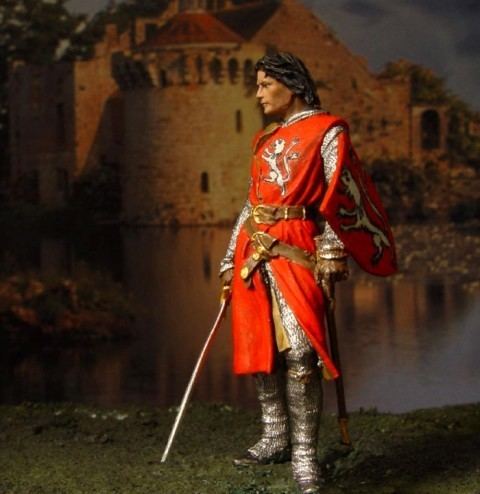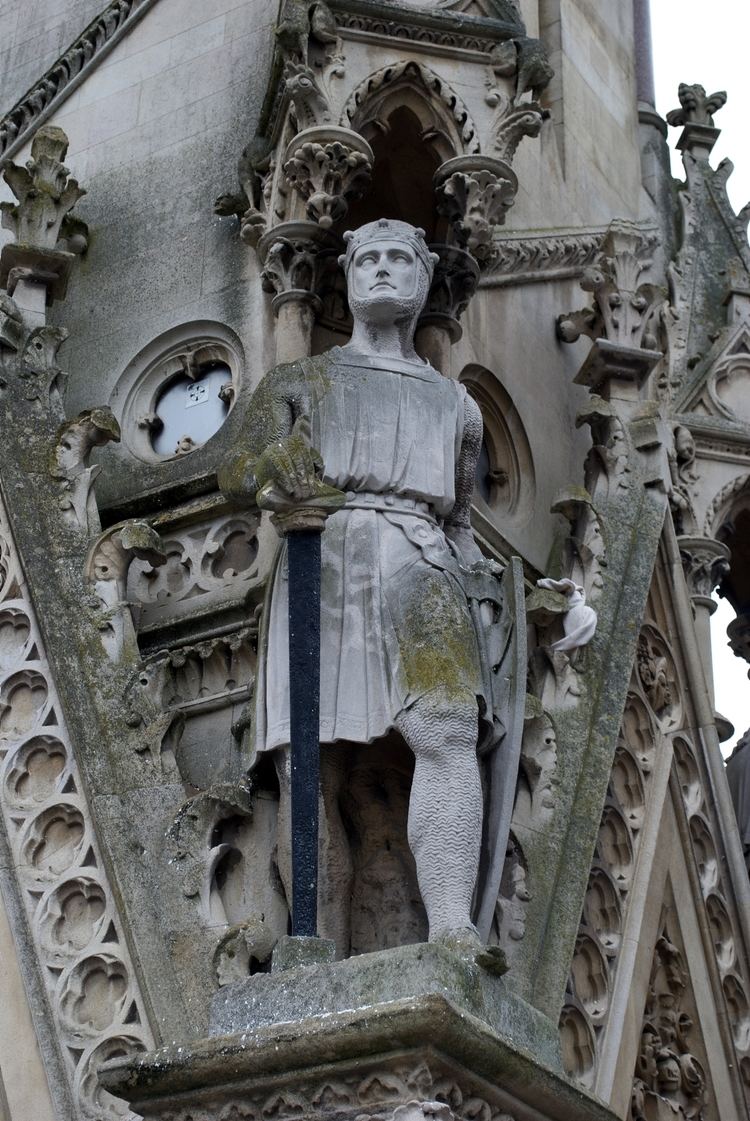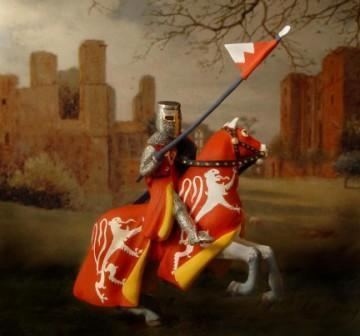Title held 1239 – 4 August 1265 Name Simon Montfort, | Successor None, title forfeit | |
 | ||
Spouse Eleanor of Leicester (m. 1238) Parents Simon de Montfort, 5th Earl of Leicester, Alix de Montncy Similar People Henry III of England, Edward I of England, Eleanor de Montfort, Eleanor of Leicester, Guy de Montfort - Count of | ||
Simon de Montfort, 6th Earl of Leicester
Simon de Montfort, 6th Earl of Leicester (c. 1208 – 4 August 1265), also called Simon de Munford and sometimes referred to as Simon V de Montfort to distinguish him from other Simons de Montfort, was a French-English nobleman who inherited the title and estates of the Earldom of Leicester in England. He led the rebellion against King Henry III of England during the Second Barons' War of 1263–64, and subsequently became de facto ruler of England. During his rule, Montfort called two famous parliaments. The first stripped the King of unlimited authority, while the second included ordinary citizens from the towns. For this reason, Montfort is regarded today as one of the progenitors of modern parliamentary democracy. After a rule of just over a year, Montfort was killed by forces loyal to the King in the Battle of Evesham.
Contents
- Simon de Montfort 6th Earl of Leicester
- Simon de Montfort 6th Earl of Leicester Paul Parnis
- Family
- Early life
- Royal marriage
- Crusade and turning against the King
- War against the King
- Rule and parliamentary reform
- Fall from power and death
- Legacy
- In fiction
- Descendants
- References

Simon de Montfort 6th Earl of Leicester - Paul Parnis
Family

Montfort was a younger son of Simon de Montfort, 5th Earl of Leicester, a French nobleman and crusader, and Alix de Montmorency. His paternal grandmother was Amicia de Beaumont, the senior c.-heiress to the Earldom of Leicester and a large estate owned by her brother Robert de Beaumont, 4th Earl of Leicester, in England.

With the irrevocable loss of Normandy, King John refused to allow the elder Simon to succeed to the earldom of Leicester and instead placed the estates and title into the hands of Montfort senior's cousin Ranulf, the Earl of Chester. The elder Simon had also acquired vast domains during the Albigensian Crusade, but was killed during the Siege of Toulouse in 1218 and his eldest son Amaury was not able to retain them. When Amaury was rebuffed in his attempt to get the earldom back, he agreed to allow his younger brother Simon to claim it in return for all family possessions in France.

Simon arrived in England in 1229, with some education but no knowledge of English, and received a sympathetic hearing from King Henry, who was well-disposed towards foreigners speaking French, then the language of the English court. Henry was in no position to confront the powerful Earl of Chester, so Simon approached the older, childless man himself and convinced him to cede him the earldom. It would take another nine years before Henry formally invested him with the title Earl of Leicester.
Simon de Montfort shared various levels of consanguinuity and "by-marriage" connections with both English and French royal lineages. For instance, his ancestor Simon I de Montfort was father of Bertrade de Montfort who herself was a paternal great-grandmother of King Henry II. He was also descended from Henry I.
Early life
As a younger son, Simon de Montfort attracted little public attention during his youth, and the date of birth remains unknown. He is first mentioned when his mother made a grant to him in 1217. As a boy, Montfort accompanied his parents during his father's campaigns against the Cathars. He was with his mother at the Siege of Toulouse in 1218, where his father died after being struck on the head by a stone pitched by a mangonel. In addition to Amaury, Simon had another older brother, Guy, who was killed at the siege of Castelnaudary in 1220. As a young man, Montfort probably took part in the Albigensian Crusades of the early 1220s. He and Amaury both took part in the Barons' Crusade.
In 1229 the two surviving brothers (Amaury and Simon) came to an arrangement with King Henry whereby Simon gave up his rights in France and Amaury gave up his rights in England. Thus freed from any allegiance to the King of France, Montfort successfully petitioned for the English inheritance, which he received the next year, although he did not take full possession for several years, and did not win formal recognition as Earl of Leicester until February 1239.
As Lord of Leicester, he expelled the small Jewish community from Leicester in 1231, banishing them "in my time or in the time of any of my heirs to the end of the world". They moved to the eastern suburbs, which were controlled by Montfort's great-aunt Margaret, Countess of Winchester. He justified his action as being "for the good of my soul, and for the souls of my ancestors and successors": inspiration may have come from the hostility his parents had shown to Jews in France, where his father was known for his devout Christianity, and where his mother had given the Jews of Toulouse a choice of conversion or expulsion; as well as from the intellectual arguments of the scholar Robert Grosseteste (at this date Archdeacon of Leicester). It was also a strategy to enhance his popularity in his new domains by banishing the practice of usury (widely associated with Jews).
Montfort became a favourite of King Henry III and even issued a charter as "Earl of Leicester" in 1236, despite having not yet been granted the title.
In that same year Simon tried to get Joan, Countess of Flanders to marry him. The idea of an alliance between the rich County of Flanders and a close associate of Henry III of England did not sit well with the French crown. The French Queen Dowager Blanche of Castile convinced Joan to marry Thomas II of Savoy instead.
Royal marriage
In January 1238, Montfort married Eleanor of England, daughter of King John and Isabella of Angoulême and sister of King Henry III. While this marriage took place with the King's approval, the act itself was performed secretly and without consulting the great barons, as a marriage of such importance warranted. Eleanor had previously been married to William Marshal, 2nd Earl of Pembroke, and she swore a vow of perpetual chastity upon his death, when she was sixteen, which she broke by marrying Montfort. The Archbishop of Canterbury, Edmund Rich, condemned the marriage for this reason. The English nobles protested the marriage of the King's sister to a foreigner of modest rank. Most notably, the King's and Eleanor's brother Richard, 1st Earl of Cornwall, rose up in revolt when he learned of the marriage. King Henry eventually bought off Richard with 6,000 marks and peace was restored.
The marriage brought the manor of Sutton Valence in Kent into Montfort's possession. Relations between King Henry and Montfort were cordial at first. Henry lent him his support when Montfort embarked for Rome in March 1238 to seek papal approval for his marriage. When Simon and Eleanor's first son was born in November 1238 (despite rumours, more than nine months after the wedding), he was baptised Henry in honour of his royal uncle. In February 1239, Montfort was finally invested with the Earldom of Leicester. He also acted as the king's counsellor and was one of the nine godfathers of Henry's eldest son, Prince Edward, who would inherit the throne and become Edward I ("Longshanks").
Crusade and turning against the King
Shortly after Prince Edward's birth, however, there was a falling out between the brothers-in-law. Simon owed a great sum of money to Thomas II of Savoy, uncle of Queen Eleanor, and named King Henry as security for his repayment. The King evidently had not approved this, and was enraged when he discovered that Montfort had used his name. On 9 August 1239, Henry is reported to have confronted Montfort, called him an excommunicant and threatened to imprison him in the Tower of London. "You seduced my sister", King Henry said, "and when I discovered this, I gave her to you, against my will, to avoid scandal." Simon and Eleanor fled to France to escape Henry's wrath.
Having announced his intention to go on crusade two years before, Simon raised funds and travelled to the Holy Land during the Barons' Crusade, but does not seem to have faced combat there. He was part of the crusading host which, under Richard of Cornwall, negotiated the release of Christian prisoners including Simon's older brother Amaury. In autumn 1241, he left Syria and joined King Henry's campaign against King Louis IX in Poitou. The campaign was a failure, and an exasperated Montfort declared that Henry should be locked up like King Charles the Simple. Like his father, Simon was a soldier as well as a capable administrator. His dispute with King Henry came about due to the latter's determination to ignore the swelling discontent within the country, caused by a combination of factors, including famine and a sense among the English Barons that King Henry was too quick to dispense favour to his Poitevin relatives and Savoyard in-laws.
In 1248, Montfort again took the cross with the idea of following Louis IX of France to Egypt. But, at the repeated requests of King Henry, he gave up this project in order to act as viceroy in the unsettled and disaffected Duchy of Gascony. Bitter complaints were excited by the rigour with which Montfort suppressed the excesses of the Seigneurs and of contending factions in the great communes. Henry yielded to the outcry and instituted a formal inquiry into Simon's administration. Simon was formally acquitted on the charges of oppression, but his accounts were disputed by Henry and Simon retired to France in 1252. The nobles of France offered him the Regency of the kingdom, vacated by the death of Queen Blanche of Castile. The earl preferred to make his peace with Henry III, which he did in 1253, in obedience to the exhortations of the dying Robert Grosseteste, Bishop of Lincoln. He helped the King deal with disaffection in Gascony, but their reconciliation was a hollow one. In the parliament of 1254, Simon led the opposition in resisting a royal demand for a subsidy. In 1256–57, when the discontent of all classes was coming to a head, Montfort nominally adhered to the royal cause. He undertook, with Peter of Savoy, the Queen's uncle, the difficult task of extricating the King from the pledges which he had given to the Pope with reference to the Crown of Sicily; and Henry's writs of this date mention Montfort in friendly terms. But at the "Mad Parliament" of Oxford (1258) Montfort appeared with the Earl of Gloucester, at the head of the opposition. He was part of the Council of Fifteen who were to constitute the supreme board of control over the administration. The King's success in dividing the barons and in fostering a reaction, however, rendered such projects hopeless. In 1261, Henry revoked his assent to the Provisions of Oxford and Montfort, in despair, left the country.
War against the King
Simon de Montfort returned to England in 1263, at the invitation of the barons who were now convinced of the King's hostility to all reform and raised a rebellion with the avowed object of restoring the form of government which the Provisions had ordained. Henry quickly gave in and allowed Montfort to take control of the council. His son Edward, however, began using patronage and bribes to win over many of the barons. Their disruption of parliament in October led to a renewal of hostilities, which saw the royalists able to trap Simon in London. With few other options available, Montfort agreed to allow Louis IX of France to arbitrate their dispute. Simon was prevented from presenting his case to Louis directly on account of a broken leg, but little suspected that the King of France, known for his innate sense of justice, would completely annul the Provisions in his Mise of Amiens in January 1264. Civil war broke out almost immediately, with the royalists again able to confine the reformist army in London. In early May 1264, Simon marched out to give battle to the King and scored a spectacular triumph at the Battle of Lewes on 14 May 1264, capturing the King, Lord Edward, and Richard of Cornwall, Henry's brother and the titular King of Germany.
Rule and parliamentary reform
Montfort used his victory to set up a government based on the provisions first established at Oxford in 1258. Henry retained the title and authority of King, but all decisions and approval now rested with his council, led by Montfort and subject to consultation with parliament. His Great Parliament of 1265 (Montfort's Parliament) was a packed assembly to be sure, but it can hardly be supposed that the representation which he granted to the towns was intended to be a temporary expedient.
Montfort sent his summons, in the King's name, to each county and to a select list of boroughs, asking each to send two representatives. This body was not the first elected parliament in England. In 1254, Henry was in Gascony and in need of money. He gave instructions for his regent, Queen Eleanor, to summon a parliament consisting of knights elected by their shires to ask for this 'aid'. Montfort, who was in that parliament, took the innovation further by including ordinary citizens from the boroughs, also elected, and it was from this period that parliamentary representation derives. The list of boroughs which had the right to elect a member grew slowly over the centuries as monarchs granted charters to more English towns. (The last charter was given to Newark in 1674.)
The right to vote in Parliamentary elections for county constituencies was uniform throughout the country, related to land ownership. In the Boroughs, the electoral franchise varied and individual boroughs had varying arrangements.
Fall from power and death
The reaction against Montfort's government was baronial rather than popular. The Welsh Marcher Lords were friends and allies of Prince Edward, and when he escaped in May 1265, they rallied around his opposition. The final nail was the defection of Gilbert de Clare, the Earl of Gloucester, the most powerful baron and Simon's ally at Lewes. Clare had grown resentful of Simon's fame and growing power. When he and his brother Thomas fell out with Simon's sons Henry, Simon, and Guy, they deserted the reforming cause and joined Edward.
Though boosted by Welsh infantry sent by Montfort's ally Llywelyn ap Gruffudd, Simon's forces were severely depleted. Prince Edward attacked his cousin, his godfather's son Simon's forces at Kenilworth, capturing more of Montfort's allies. Montfort himself had crossed the Severn with his army, intending to rendezvous with his son Simon. When he saw an army approaching at Evesham, Montfort initially thought it was his son's forces. It was, however, Edward's army flying the Montfort banners they had captured at Kenilworth. At that point, Simon realised he had been out-manoeuvred by Edward.
An ominous black cloud hung over the field of Evesham on 4 August 1265 as Montfort led his army in a desperate uphill charge against superior forces, described by one chronicler as the "murder of Evesham, for battle it was none". On hearing that his son Henry had been killed, Montfort replied, "Then it is time to die." During the battle, a twelve-man squad of Edward's men had stalked the battlefield independent of Edward's main army, their sole aim being to find the earl and cut him down. Montfort was hemmed in; Roger Mortimer killed Montfort by stabbing him in the neck with a lance. Montfort's last words were said to have been "Thank God". Also slain with Montfort were other leaders of his movement, including Peter de Montfort and Hugh Despenser.
Montfort's body was mutilated in a frenzy by the royalists. News reached the mayor and sheriffs of London that "the head of the earl of Leicester ... was severed from his body, and his testicles cut off and hung on either side of his nose"; and in such guise the head was sent to Wigmore Castle by Roger Mortimer, 1st Baron Mortimer, as a gift to his wife, Maud. His hands and feet were also cut off and sent to diverse places to enemies of his as a great mark of dishonour to the deceased. Such remains as could be found were buried under the altar of Evesham Abbey by the canons. It was visited as holy ground by many commoners until King Henry caught wind of it. He declared that Montfort deserved no spot on holy ground and had his remains reburied under an insignificant tree. The remains of some of Montfort's soldiers who had fled the battlefield were found in the nearby village of Cleeve Prior.
Montfort's niece, Margaret of England, later killed one of the soldiers responsible for his death, purposely or inadvertently.
Matthew Paris reports that the Bishop of Lincoln, Robert Grosseteste, once said to Montfort's eldest son, Henry, "My beloved child, both you and your father will meet your deaths on one day, and by one kind of death, but it will be in the name of justice and truth."
Legacy
In the years that followed his death, Simon de Montfort's grave was frequently visited by pilgrims. Napoleon Bonaparte described Simon de Montfort as "one of the greatest Englishmen". Today, Montfort is mostly remembered as one of the fathers of representative government.
Evesham Abbey and the site of Montfort's grave were destroyed with the Dissolution of the Monasteries in the 16th century. In 1965 a memorial of stone from Montfort-l'Amaury was laid on the site of the former altar by Speaker of the House of Commons Sir Harry Hylton-Foster and Archbishop of Canterbury, Michael Ramsey.
Various local honours were dedicated to his memory, and he has become eponymous several times over. De Montfort University in Leicester is named after him, as is the nearby De Montfort Hall, a concert venue. A statue of Montfort is one of four to adorn the Haymarket Memorial Clock Tower in Leicester. A Relief of Montfort adorns the wall of the Chamber of the United States House of Representatives.
Montfort's banner called the 'Arms of Honour of Hinckley', blazoned Per pale indented argent and gules, and displayed in stained glass in Chartres Cathedral, is especially used in the coat of arms of the town of Hinckley, part of his Earldom in Leicestershire, and by many of its local organizations. Combined with his personal Coat of Arms, the banner forms part of the club crest for the town's football club Hinckley A.F.C.
A school and a bridge on the north east stretch of the A46 are named after him in Evesham.
In fiction
Sharon Penman's novel, Falls the Shadow, is a fictional retelling of Montfort's life from his arrival in England to his death. Montfort is the subject of four speculative novels, Montfort Vols. I-IV, by Katherine Ashe. He is also the focus of the second volume of The Brothers of Gwynedd Quartet by Edith Pargeter; the four books tell the story of Llewellyn Prince of Wales, who married Simon's daughter Eleanor, and his three brothers. Virginia Henley's The Dragon and the Jewel is the story of Eleanor's marriage to Montfort. Simon de Montfort and (especially) Eleanor feature in Doctor Mirabilis by James Blish, a semi-fictional novel about Roger Bacon.
Descendants
Simon de Montfort and Eleanor of Leicester had seven children, many of whom were notable in their own right:
- Henry de Montfort (November 1238 – 1265)
- Simon the Younger de Montfort (April 1240 – 1271)
- Amaury de Montfort, Canon of York (1242/1243-1300)
- Guy de Montfort, Count of Nola (1244–1288). Elizabeth Woodville, Queen Consort of Edward IV of England, was one of Guy's descendants through his daughter, Anastasia de Montfort, Countess of Nola.
- Joanna de Montfort (born and died in Bordeaux between 1248 and 1251).
- Richard de Montfort (d.1266). Date of death is not certain.
- Eleanor de Montfort (1252–1282). She married Llywelyn ap Gruffudd, Prince of Wales, honouring an agreement that had been made between Earl Simon and Llywelyn. Eleanor, Lady of Wales, died on 19 June 1282 at the royal Welsh home at Abergwyngregyn, on the north coast of Gwynedd, giving birth to a daughter, Gwenllian of Wales. After Llywelyn's death on 11 December 1282, Gwenllian was captured by King Edward I and spent the rest of her life in a convent.
